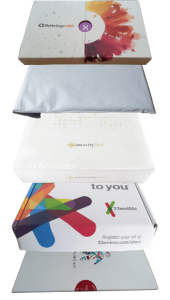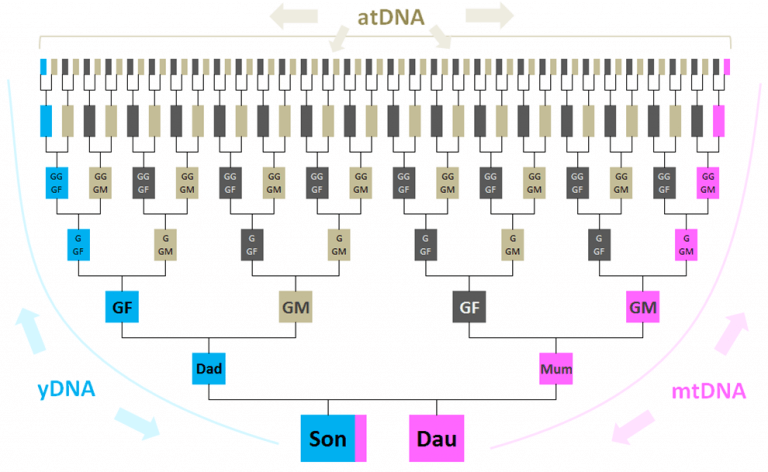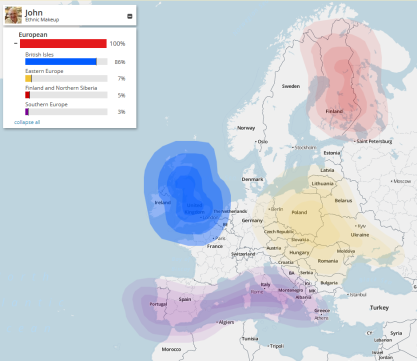Family history groups and societies have been abuzz with excitement over recent years, as DNA testing becomes mainstream for genealogists, and more and more are incorporating DNA evidence into their family history research. Many new family history group members turn up with just DNA test results, and no prior research – lured by the excitement of their DNA results to start learning how to research their family history.
Due to technological advances and affordable prices, DNA testing is now being widely used to confirm family lines and connect with biological relatives.
You may want to discover branches of your tree not found through regular research, confirm or disprove family relationships, find cousins with whom to share research & photos, see if persons who share your surname are related, discover your ancient origins, potentially solve long-standing research ‘dead-ends’ (aka ‘brick walls’), explore the validity of family stories, identify previously unknown close family (eg. adoptees searching for parents), or you may simply be curious to see what your DNA reveals.
Don’t let the scientific nature of DNA scare you off, as once the basic test types are understood, the minimum technical know-how required is the use of email and messaging in order to contact your DNA matches.
Collaborate with your new-found genetic relatives using your traditional genealogical skills to determine your ancestors-in-common.
For those who want to delve deeper, there are many free tools and learning resources.
A DNA kit is ordered online from one of the major DNA testing companies.
Your test kit arrives by mail or courier within a few days to a few weeks, depending on company.
The DNA tests themselves are very simple to use:
After testing, you simply post your sample back in the pre-addressed envelope or package.
All notifications are via email and results are provided via an online account.


Once your DNA has been tested, your results are added to a very large database and you access them via your online account (nothing is sent by mail).
Even if you have no close matches initially, large numbers of people are testing each week (including from Australia, NZ, UK & Ireland), and you will continue to receive new matches regularly.
Your online account is also used to keep track of your order status, to enter your family tree and ancestral surname information, to join projects, to see your results and which people you match, to manage your profile and tree settings, and to download a copy of your DNA raw data file (for use with additional tools/sites).
There are several different types of DNA that can be tested for genealogical purposes:

Y-chromosome DNA (Y-DNA): Males inherit a y-chromosome from their father, through his father, his father, his father, etc, on the direct paternal line, as per the blue boxes on the chart above. Refer to Y-DNA: the Direct Paternal Line for more detailed information, pedigree charts and examples of how Y-DNA testing can be useful in your family history research.
Mitochondrial DNA (mtDNA): Everyone inherits mitochondrial DNA from their mother, through her mother, her mother, her mother, etc. on the direct maternal line, as per the pink boxes on the chart above. Refer to mtDNA: the Direct Maternal Line for more detailed information, pedigree charts and examples of how mtDNA testing can be useful in your family history research.
Autosomal DNA (atDNA): Autosomal DNA is inherited from all ancestral lines, so anyone can be tested and your matches may descend from anyone on your pedigree chart, up to about 6 generations back (but may be further). Refer to atDNA: Matches on All Ancestral Lines for more detailed information, pedigree charts and examples of how atDNA testing can be useful in your family history research.
X-chromosome DNA (X-DNA): X-chromosomes follow specific inheritance patterns, which are different for males and females. If you share X-DNA with a match, your shared ancestors will be restricted to particular lines of your pedigree. Refer to X-DNA’s helpful inheritance patterns for more detailed information & pedigree charts related to X-DNA inheritance.
For more details refer to What type of DNA tests are available?
Autosomal DNA tests include an estimate of your ethnic ancestry, including cluster maps and population migration maps showing where your ancestors came from hundreds or up to a few thousand years ago (example at right: Family Tree DNA’s myOrigins).
In FTDNA, the map may also display pins showing the locations of your matches’ most distant known ancestors.
For those who are interested, other tools allow your DNA kit to be compared with ancient DNA, such as Neanderthal.

23andMe in the US was initially a health reporting company that expanded into genealogy matching. 23andMe does not make health reports available in Australia or New Zealand. Limited health reporting is available to residents of the US, UK, Ireland and Canada.
MyHeritage DNA was selling MyHeritage DNA Health + Ancestry kits, including to Australian and New Zealand customers, but Health reports are now only available as an upgrade to an ancestry test.
Autosomal DNA raw data from AncestryDNA, MyHeritage DNA, Family Tree DNA, 23andMe, and/or Living DNA may be uploaded to promethease.com to generate health reports, for a cost of around US$5. Refer to the information and videos on the Promethease home page.
There are five major DNA testing companies for genealogy – AncestryDNA, MyHeritage DNA, Family Tree DNA, 23andMe, and Living DNA.
AncestryDNA‘s database is the largest with more than 25 million testers worldwide (Nov 2023). The huge collection of member trees can be linked to DNA results to help identify relatives through suggested Common Ancestors. You don’t need a subscription to test, view your results or contact your DNA matches, but some DNA matching features work best with a subscription and a public family tree.
MyHeritage DNA is growing very fast with more than 7.5 million testers (Nov 2023), and many millions of users so will continue to grow quickly. MyHeritage provides some great DNA tools and features. A subscription is not required to test, view or contact your matches, but you’ll get the most from your DNA results with a subscription and a public tree.
Family Tree DNA is popular with testers worldwide as it has been around since 2000, it sells internationally, sells multiple test types, requires no ongoing subscription, hosts thousands of surname and geographical projects, and provides easy analysis tools. FTDNA has around 1.5 million testers in its atDNA database (June 2023).
23andMe‘s database contains more than 14 million testers (2023), although they are generally more health-focused rather than interested in genealogy. It has some great analysis tools and highly-regarded ethnicity results, but its choice of international shipping makes it very expensive for Australians and New Zealanders (who do not receive any health reports).
Living DNA breaks down your ancestry into 80 worldwide regions, including 21 British regions. Irish, German and Scottish regions will be added in the future (existing results will be updated). Living DNA’s customer matching launched recently, with mostly British and Australian matches (which is great for us!). The numbers are low (eg. a few hundred thousand), but their database will grow as more people test, transfer and opt in to matching.
For a review of features and pricing of the three DNA testing companies, refer to Which DNA testing company should I use?
Family Tree DNA hosts around 10,500 projects, including projects for surnames, geographical regions and haplogroups.
Australian Citizens, Australian Settler Arrivals, Australian Convicts, New Zealand Genetic, New Zealand Provincial, British Isles by County, Ireland Y-DNA, Ireland mtDNA, Italy DNA Project are just a few projects that may be of interest.
Currently, the favourite test type amongst genealogists who don’t have a specific need to test the direct male or female lines is an autosomal DNA test.
AncestryDNA, MyHeritage DNA and Family Tree DNA are very popular in Australia & New Zealand, but review your goals and the features of each genealogy testing company before you buy, to ensure your choice suits your needs. 23andMe is a little less popular here due to its price (but great to do if you’ve already done all the others, or to get your DNA into all the databases) and Living DNA‘s new family matching feature has launched in Beta, so you may only have a few matches now but match lists will grow in the future.
Expect to be matched with a range of biological relatives, up to 5th cousins back or further.
Once your results are released, you can start corresponding with your matches and comparing trees and research to determine your shared ancestors. As more people test, everyone’s chance of finding closer matches improves. It is also very useful to test siblings and other cousins, as they may share DNA with cousins that you don’t.
For beginners, there are plenty of free links and resources. As you gain experience, there are third-party sites & tools you can utilise to analyse your results and find additional matches.
For Facebook users, there are some great support groups, including: Using DNA for Genealogy – Australia & NZ, DNA for Genealogy – UK, DNA Detectives Down Under (for adoptees or people with unknown parentage), DNA for the Donor Conceived, Genetic Genealogy Tips & Techniques, and the International Society of Genetic Genealogy.
The International Society of Genetic Genealogy (ISOGG)’s Wiki provides information and links to resources on everything related to genetic genealogy.
Exploit your DNA to make exciting new discoveries in your family tree!